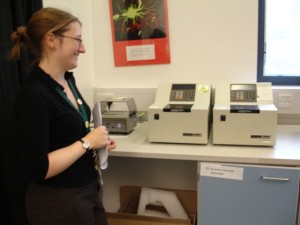My colleague Graham Bradshaw is currently managing a project called Science & Society. The aim is to accession objects into the collection that reflect the important role science plays in our lives today.
Following discussions with our colleagues over the road at the Centre for Life Graham has just collected a Perkin – Elmer DNA Thermal Cycler 480 Polymerase Chain Reaction (PCR) machine. I had to ask Graham to explain why the machine is significant.
He explained that, “This very ordinary looking piece of lab equipment, pioneered by the American company Perkin-Elmer, revolutionised D.N.A research and our knowledge of genetics. It did this by greatly speeding up the amplification of D.N.A by the polymerase chain reaction process (P.C.R). In the P.C.R process the amount of D.N.A in a sample is doubled at each stage, meaning just one strand of DNA can be amplified to over a billion strands in just 30 cycles. The ability to create large amounts of DNA from a tiny starting sample has enabled scientists to accelerate their groundbreaking research in fields as diverse as genetics, forensics and palaeontology.
P.C.R involves the very precise heating and cooling of samples of D.N.A. The process was originally done very laboriously using three separate water baths. The sample had to be moved between the different temperature baths by hand. Then Perkin – Elmer developed the thermal cycler, which with its computer controlled electrically heated test tube block allowed more samples to be processed more quickly and more accurately. The latest machines can now control the samples at different temperature gradients across the heating block to optimise results”.
Dr Nicola Stock, Education Officer at Life, told Graham that
“I’ve used PCR machines throughout my time in research and used this model of Perkin-Elmer thermal cycler when I first started out in my undergraduate research project in Cambridge. I used the machine to amplify viral DNA from patient samples – baby’s diarrhoea, not very nice – and look for differences in the sequences.
I don’t consider myself as old and find it unbelievable that a machine that I first used only fifteen years ago is already a museum piece.”

